Hassaleh, Iota Aurigae (ι Aur), is an orange bright giant star located in the constellation Auriga, the Charioteer. With an apparent magnitude of 2.69, it is the fourth brightest star in Auriga, after Capella, Menkalinan and Mahasim. Hassaleh lies at an approximate distance of 490 light years from Earth. It serves as a spectral standard for its class.
Star type
Hassaleh is a bright giant star of the spectral type K3 II. It has a mass 7.1 times that of the Sun and a radius 127 times solar. With a surface temperature of 4,160 K, it is 4,581 times more luminous than the Sun. The star is a relatively slow spinner, with a projected rotational velocity of 8 km/s. Its estimated age is about 39.8 million years.
Even though Hassaleh is a young star, it has evolved quickly due to its high mass and will not have a very long life. With 7.1 solar masses, it will probably not go out as a supernova when it comes to the end of its life cycle. Instead, it will expel its outer layers and gradually fade away as a massive white dwarf.
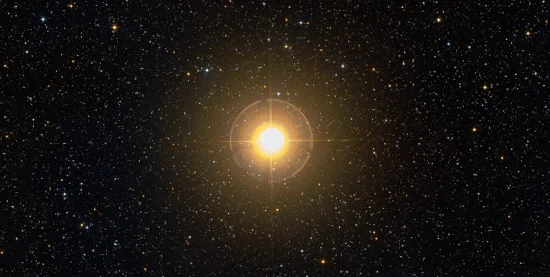
Hassaleh (Iota Aurigae), image: Wikisky
Hassaleh is a suspected variable star, but its light variability has not yet been confirmed and the mechanism responsible for the variations is unknown.
Facts
Two substellar objects orbiting Hassaleh were announced in June 2007. The objects were reported to be in 2:1 resonance. Their existence has not yet been confirmed, but it they are real, they would probably be brown dwarfs orbiting the host star with periods of about 2 and 4 years. The objects were detected using the radial velocity method and the team who conducted the survey reported significant radial velocity variations with periods of 767 and 1586 days.
Hassaleh is one of the bright stars that form Auriga’s recognizable pentagon (or hexagon) pattern. The other stars that form the pentagon are Capella (Alpha Aurigae), Menkalinan (Beta Aurigae), Mahasim (Theta Aurigae), and Elnath (Beta Tauri). The fainter Almaaz (Epsilon Aurigae) makes the asterism a hexagon.
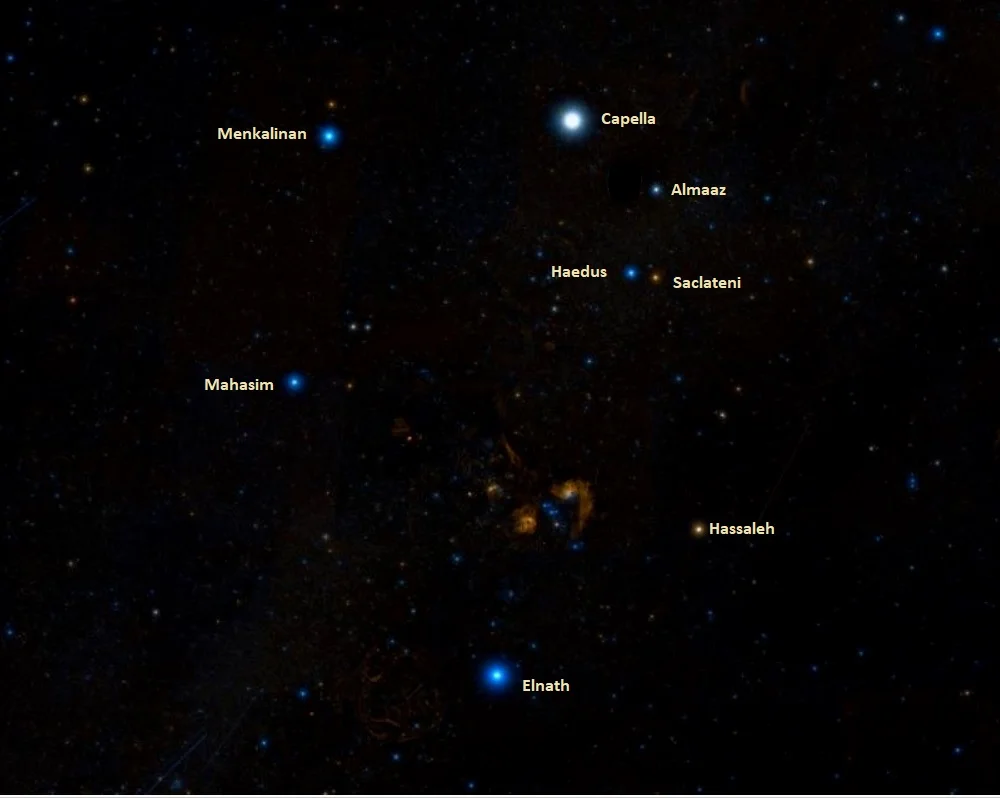
Auriga stars, image: Wikisky
Iota Aurigae has served as a stable anchor point for the Morgan-Keenan system of spectral classification since 1943. The MK system is used to classify stars based on the appearance of their spectra. Hassaleh is used as a spectral standard for its class (K3 II).
Hassaleh lies 490 light years away and some of its light is absorbed by interstellar dust and gas. Without extinction, it would be 0.6 magnitudes brighter.
Name
The name Hassaleh (pronunciation: /ˈhæsəleɪ/) comes from Czech astronomer Antonín Bečvář’s Atlas Coeli Skalnate Pleso (1951), but its origin is unknown. The name was officially approved by the International Astronomical Union’s (IAU) Working Group on Star Names (WGSN) on June 30, 2016.
Iota Aurigae was also traditionally known as Kabdhilinan (pronunciation: /kæbˈdɪlɪnæn/), Alkab or Al Kab. These names are derived from the Arabic kaʽb ðīl-ʽinān, meaning “the ankle.” The star marks the left ankle of Auriga, the Charioteer.
In Chinese astronomy, Hassaleh is known as 五車一, the First Star of the Five Chariots. It forms the Five Chariots asterism with Capella (Alpha Aurigae), Menkalinan (Beta Aurigae), Mahasim (Theta Aurigae), and Elnath (Beta Tauri), the same stars that form Auriga’s pentagon. The asterism is part of the Net mansion, which represents the body of the White Tiger.
Location
Hassaleh is easy to find because it lies in an area full of bright stars and is part of Auriga’s conspicuous pentagon. It is the brightest of the several stars on the western (right) side of the asterism, going clockwise from Capella to Elnath.
Auriga is located just north of the constellation Orion, recognizable for its hourglass pattern with the prominent Belt of Orion in the middle. Capella, Auriga’s brightest star, is part of the Winter Circle (Winter Hexagon), a large asterism composed of six first-magnitude stars that dominates the winter sky in the northern hemisphere. The Winter Hexagon is formed by Capella with Sirius in the constellation Canis Major, Procyon in Canis Minor, Pollux in Gemini, Aldebaran in Taurus, and Rigel in Orion. Capella is the northernmost (top) star of the asterism.
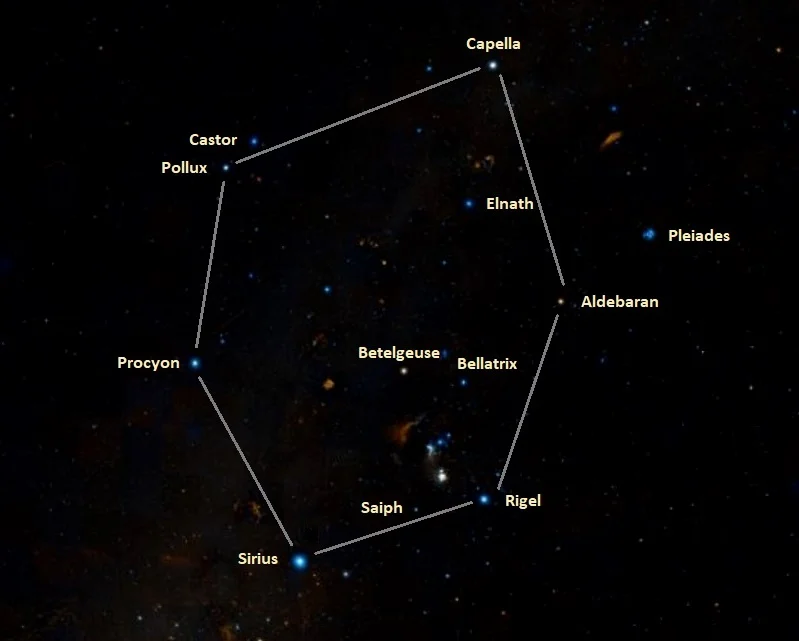
Auriga location, image: Wikisky
Hassaleh and Mahasim can be used to find several relatively bright deep sky objects that lie in the region between the two stars. The Pinwheel Cluster (Messier 36) is an open cluster with an apparent magnitude of 6.3 that can be found along the imaginary line connecting Menkalinan and Elnath. The Starfish Cluster (Messier 38), another open cluster, has a visual magnitude of 7.4 and lies on the line connecting Elnath and Capella. The open cluster NGC 1893 (mag. 7.5) lies 12,400 light years away and is embedded in the emission nebula IC 410, also known as the Tadpole Nebula. The cluster and the nebula appear just south of the line connecting Hassaleh and Mahasim.
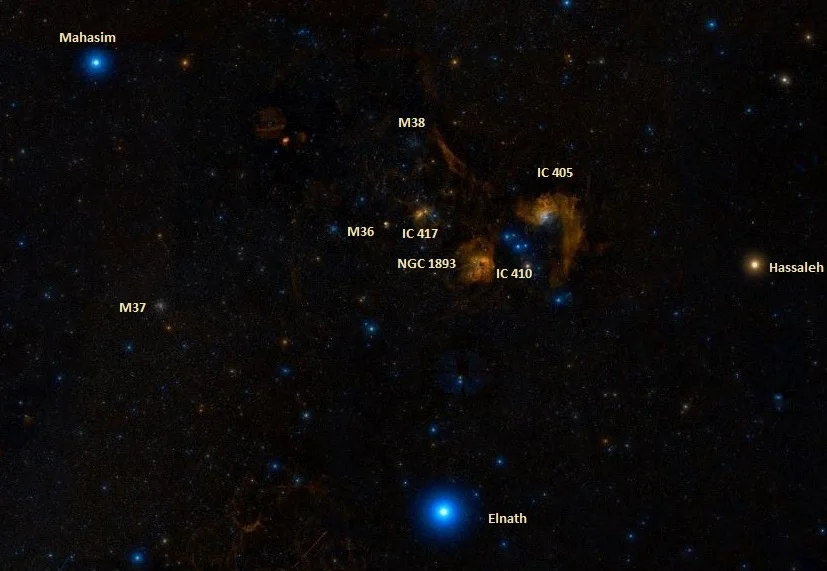
Mahasim, Hassaleh, Elnath, Messier 36, Messier 37, Messier 38 and the Flaming Star Nebula, image: Wikisky
The emission nebula IC 417 and the smaller emission and reflection nebula NGC 1931 (also known as the Spider and the Fly) appear just west of Messier 36. Both nebulae contain young open clusters and are located about 10,000 and 7,000 light years away.
The Flaming Star Nebula (IC 405) is a large emission and reflection nebula located much closer to us, at a distance of 1,500 light years. Appearing about two thirds of the distance from Mahasim to Hassaleh, the nebula is illuminated by the light of the O-type variable star AE Aurigae.
Constellation
Hassaleh is located in the constellation Auriga. The celestial Charioteer is one of the most conspicuous northern constellations, with four of its brightest stars forming a distinct pentagon with Elnath in Taurus. Auriga is one of the larger constellations – the 21st in size out of 88 – occupying 657 square degrees of the northern sky. It is one of the 48 ancient constellations catalogued by the Greek astronomer Ptolemy of Alexandria in the 2nd century CE. In Greek mythology, it is associated with Erichthonius of Athens, the inventor of the quadriga (four-horse chariot), and with the goat Amalthea, who nursed the infant Zeus.
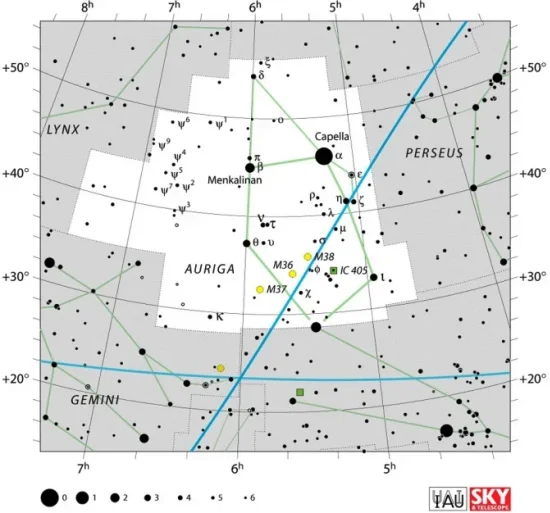
Auriga constellation map by IAU and Sky&Telescope magazine
Auriga is best known for its bright stars Capella and Menkalinan, the sixth and 41st brightest stars in the sky, and for the three bright Messier open clusters: Messier 36, Messier 37 and Messier 38.
Other notable stars in the constellation include the Algol-type eclipsing binary systems Beta Aurigae (Menkalinan), Epsilon Aurigae (Almaaz), and Zeta Aurigae (Saclateni), the Orion variable AE Aurigae, and the slow irregular variable Pi Aurigae.
In addition to the Messier clusters, deep sky objects in Auriga include the open clusters NGC 1664 (the Kite Cluster), NGC 2281, and NGC 1893, the protoplanetary Westbrook Nebula (CRL 618), the emission and reflection nebula IC 405 (the Flaming Star Nebula), and the emission nebula IC 410, which surrounds the open cluster NGC 1893.
The best time of year to observe the stars and deep sky objects of Auriga is in late February and early March, when the constellation reaches its highest point in the evening sky. The entire constellation is visible from locations between the latitudes 90° N and 40° S.
The 10 brightest stars in Auriga are Capella (Alpha Aur, mag. 0.08), Menkalinan (Beta Aur, mag. 1.90), Mahasim (Theta Aur, mag. 2.62 – 2.70), Hassaleh (Iota Aur, mag. 2.69), Almaaz (Epsilon Aur, mag. 2.92 – 3.83), Haedus (Eta Aur, mag. 3.18), Saclateni (Zeta Aur, mag. 3.70 -3.97), Delta Aurigae (mag. 3.715), Nu Aurigae (mag. 3.957), and Pi Aurigae (mag. 4.25).
Hassaleh – Iota Aurigae
| Spectral class | K3 II |
| Variable type | Suspected |
| U-B colour index | +1.78 |
| B-V colour index | +1.53 |
| Apparent magnitude | 2.69 |
| Absolute magnitude | -3.20 |
| Distance | 490 ± 30 light years (151 ± 9 parsecs) |
| Parallax | 6.61 ± 0.38 mas |
| Radial velocity | +17.78 ± 0.25 km/s |
| Proper motion | RA: +6.79 ± 0.42mas/yr |
| Dec.: -14.88 ± 0.27 mas/yr | |
| Mass | 7.1 ± 0.7 M☉ |
| Luminosity | 4,581 L☉ |
| Radius | 127 R☉ |
| Temperature | 4,160 K |
| Metallicity | -0.11 dex |
| Age | 39.8 ± 4.9 million years |
| Rotational velocity | 8 km/s |
| Surface gravity | 1.74 cgs |
| Constellation | Auriga |
| Right ascension | 04h 56m 59.6210887s |
| Declination | +33° 09′ 57.958479″ |
| Names and designations | Hassaleh, Kabdhilinan, Iota Aurigae, ι Aur, 3 Aurigae, HD 31398, HR 1577, HIP 23015, SAO 57522, FK5 181, GC 6029, GCRV 2923, PPM 69775, BD+32°855, AG+33 456, CSV 463, JP11 949, AAVSO 0450+33, IRAS 04537+3305, 2MASS J04565963+3309578, PLX 1100.00, UBV 4742, TYC 2391-1446-1 |